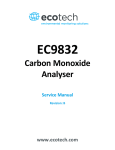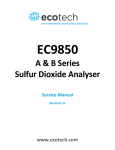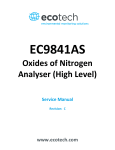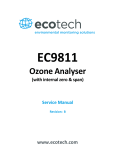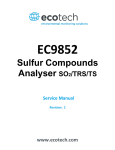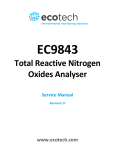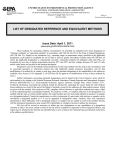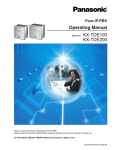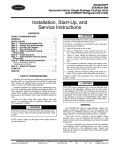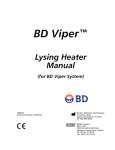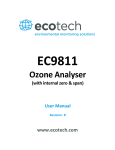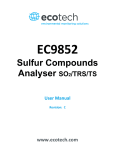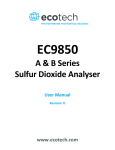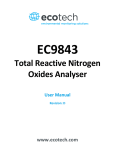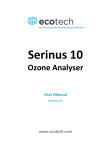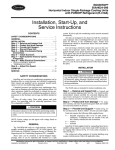Download EC9820 Service Manual
Transcript
Carbon Dioxide Analyser Service Manual Revision: B www.ecotech.com EC9820 CO2 ANALYZER SERVICE MANUAL Table of Contents MANUAL HISTORY ....................................................................................................................................................3 SAFETY REQUIREMENTS ............................................................................................................................................4 SERVICE AND SPARE PARTS .......................................................................................................................................4 1. 0 INSTALLATION..................................................................................................................................................5 1.1 INITIAL CHECK ....................................................................................................................................................5 1.1.1 Remove the Top Cover ................................................................................................................................5 1.1.2 Service Switch .............................................................................................................................................6 1.1.3 Inspect the Components ..............................................................................................................................6 1.1.4 Reinsert Dislodged Boards..........................................................................................................................7 1.1.5 Cable Connections ......................................................................................................................................7 2. 0 THEORY OF OPERATION ...............................................................................................................................9 2.1 INSTRUMENT DESCRIPTION ................................................................................................................................10 2.1.1 Power/Microprocessor Module.................................................................................................................10 2.1.2 Sensor Module...........................................................................................................................................12 2.2 OPERATION MODES ...........................................................................................................................................16 2.2.1 Startup Mode.............................................................................................................................................16 2.2.2 Measure Modes .........................................................................................................................................18 2.2.3 Auto Zero Routines....................................................................................................................................18 3. 0 MAINTENANCE................................................................................................................................................20 3.1 MAINTENANCE SCHEDULE .................................................................................................................................20 3.2 REPLACEABLE PARTS ........................................................................................................................................21 3.2.1 Expected Life Span of Consumables .........................................................................................................22 3.3 MAINTENANCE PROCEDURES.............................................................................................................................23 3.3.1 Check Particulate Filter............................................................................................................................24 3.3.2 Particulate Filter Replacement Procedure ...............................................................................................24 3.3.3 Clean Fan Filter........................................................................................................................................25 3.3.4 Detector Signal Adjustment.......................................................................................................................26 3.3.5 Correlation Wheel/Motor/IR Source Replacement ...................................................................................27 3.3.6 IR Detector Replacement ..........................................................................................................................28 3.3.7 Leak Test Procedure .................................................................................................................................29 3.4 HIDDEN MENU ...................................................................................................................................................29 3.4.1 Pressure & Flow Calibration sub-menus..................................................................................................31 3.4.2 FACTORY DIAGNOSTICS MENU ...........................................................................................................32 3.5 PRESSURE & FLOW CALIBRATION .....................................................................................................................32 3.5.1 Pressure/Flow Calibration........................................................................................................................32 3.6 PREPROCESSOR DEVICE ID ENTRY ....................................................................................................................35 3.7 FIRMWARE UPDATE ...........................................................................................................................................36 4. 0 TROUBLESHOOTING .....................................................................................................................................39 4.1 DC POWER SUPPLY VOLTAGES .........................................................................................................................39 4.2 TROUBLESHOOTING THE EC9820 ANALYZER ....................................................................................................39 4.2.1 Preprocessor Pots Menu ...........................................................................................................................40 4.2.2 Flow Control Pots Menu (A Series only) ..................................................................................................40 4.2.3 Valve Test Menu........................................................................................................................................41 4.2.4 Event Log ..................................................................................................................................................41 4.2.5 Instrument Status.......................................................................................................................................44 4.2.6 System Temperatures ................................................................................................................................44 4.2.7 System Faults ............................................................................................................................................45 4.3 TEST FUNCTIONS ...............................................................................................................................................46 4.3.1 Optic..........................................................................................................................................................46 98207601 Rev. B 1 EC9820 CO2 ANALYZER SERVICE MANUAL 4.3.2 Preamp......................................................................................................................................................46 4.3.3 Electric ......................................................................................................................................................46 4.3.4 Use of Diagnostic Modes ..........................................................................................................................46 4.4 TROUBLESHOOTING GUIDE ................................................................................................................................47 INDEX ........................................................................................................................................................................49 2 98207601 Rev B EC9820 CO2 ANALYZER SERVICE MANUAL Manual History The scope of this new manual covers the following analyzers: EC9820 Carbon Monoxide Analyzer, 3000 ppm , PN: 98201000-101. EC9820 Carbon Monoxide Analyzer, 1500 ppm, PN: 98201000-102 EC9820 Carbon Monoxide Analyzer, 750 ppm, PN: 98201000-103 EC9820 Carbon Monoxide Analyzer, 3000 ppm, PN: 98205000-101 Systems EC9820 Carbon Monoxide Analyzer, 1500 ppm, PN: 98205000-102 Systems EC9820 Carbon Monoxide Analyzer, 750 ppm, PN: 98205000-103 Systems This instrument is manufactured by Ecotech P/L in Australia and support the new (SMD) Microprocessor Board (Part number 98000063-4). This manual is current for firmware version 1.18 and above. This manual should only be used in conjunction with the EC9820 Carbon Monoxide Analyzer, Operation Manual PN: 98207600 Rev B, April 2007 Ecotech Manual ID: Manual PN: Current Revision: Date Released: Description: MAN 0006. 98207601. B. April 2007. EC9820 Carbon Monoxide Analyzer, Service Manual,. Revision History Rev Date Summary Affected Pages A September 2005 New Release for new Microprocessor Board Based on original manuals. All B April 2007 Updated specifications, language and links within pdf manual created. All 98207601 Rev. B 3 EC9820 CO2 ANALYZER SERVICE MANUAL Safety Requirements To reduce risk of personal injury caused by electrical shock, follow all safety notices and warnings in this documentation. This equipment should always be used with a protective earth installed. The EC9820 is compliant with the requirements of EN61010-1 A2:1995, Safety Requirements for Equipment for Measurement, Control, and Laboratory Use. If the equipment is used for purposes not specified by the manufacturer, the protection provided by this equipment may be impaired. Replacement of any part should only be carried out by qualified personnel, only using parts specified by the manufacturer. Always disconnect power source before removing or replacing any components. Surfaces marked with a “Caution, Hot Surface” (see internationally recognized symbols on page 4) sticker may get hot and deliver burns. Measure the temperature on the surface before making any contact with it. Equipment Rating 100-120/220-240V~ ±10% 50/60 Hz 250 VA max FUSE: 5/3.15A T 250V All wiring must be in accordance with local norms and be carried out by experienced personnel. Service and Spare Parts For world wide customer service & spare parts contact ECOTECH: 4 Address: Ecotech Pty Ltd 1492 Ferntree Gully Rd Knoxfield Australia. VIC 3180 Phone: Fax: (+61) 1300 364 946 (+61) 1300 668 763 Email - Service: Email - Spare Parts: [email protected] [email protected] Web: www.ecotech.com.au 98207601 Rev B CHAPTER 1 INSTALLATION 1.0 Installation 1.1 Initial Check Verify that the serial number label on the documentation and the serial number(s) on the analyzer match. Check to make certain your instrument arrived undamaged. If you find damage, report it as described in the preface, on the page titled Claims for Damaged Shipments and Shipping Discrepancies in the Operation manual. Analyzers are shipped ready to power up. Occasionally, however, rough handling during shipment causes dislodged PC boards, disconnected cables, or incorrectly positioned switches. Verify that your instrument is in operating condition by performing the following procedure. 1.1.1 Remove the Top Cover Grasp the front top corners of the front panel and pull forward. The panel will pop loose and pivot forward. See Figure 1. The top cover retaining hardware is then visible as shown in Figure 2. Use a screwdriver to unscrew the two captive screws. When the two captive screws are loosened, slide the cover backward about 4 inches and lift the top cover straight up. Figure 1. Opening the Front Panel 98207601 Rev. B 5 EC9820 CO2 ANALYZER SERVICE MANUAL 1.1.2 Service Switch Opening the front panel allows a view of the secondary panel where four switches are visible. The position of the toggle switches for operating mode is: DC Power Pump ServiceIN ON ON The Reset switch is not a toggle switch and is only activated when pressed. It resets the microprocessor. The pump switch is not applicable to the B-line instrumentation because the flow is generated through the use of an external pump. When in the OUT position, the Service switch sets the OUT OF SERVICE bit in the 50-pin I/O interface and in the status word from the serial port. The OUT position has no other effect on the operation or validity of the data obtained from the analyzer. When the Service switch is set from OUT to IN, the instrument returns to the normal operating conditions. Figure 2. The Secondary Panel 1.1.3 Inspect the Components Verify that the components were not damaged in shipping. If any PC boards are dislodged or cables disconnected, follow the instructions below. 6 98207601 Rev B CHAPTER 1 INSTALLATION 1.1.4 Reinsert Dislodged Boards The bottom edge of the boards must be held in place by the guides. The top of the boards must be attached to the metal bulkheads by the plastic or metal studs with spring tips. 1.1.5 Cable Connections The cable connectors and the board connectors must be matched securely in place for correct connection. The red indicator on each cable must be positioned at the arrowhead mark on the board connector. Make the connection by pressing the cable connector into the mating connector until a click is heard. Then, fold the retainers inward to secure the connection (see Figure 3). Figure 3. Cable Connections 98207601 Rev. B 7 EC9820 CO2 ANALYZER SERVICE MANUAL This page is intentionally left blank. 8 98207601 Rev B CHAPTER 2 THEORY OF OPERATION 2.0 Theory of Operation Carbon Dioxide absorbs infrared radiation (IR) at wavelengths near 4.5 microns; therefore, the presence and the amount of CO2 can be determined by the amount of absorption of the IR. The EC9820 analyzer uses gas filter correlation to compare the detailed IR absorption spectrum between the measured gas and other gases present in the sample being analyzed. A highly concentrated sample of the measured gas, i.e., CO2 is the filter for IR transmitted through the analyzer, thus gas filter correlation. The process further defined consists of radiation from the IR source encountering a gas filter wheel alternating between CO2, N2, and a mask. The radiation passes through a multiple pass measurement cell where the sample gas absorption process occurs, then through a narrow-band-pass filter to limit absorption to optical wavelengths of interest for CO2 absorption, after which it encounters the IR detector where the amount of absorption is measured. The N2 filter in the gas filter correlation wheel is transparent to IR and yields a measure beam that can be absorbed by CO2 in the measurement cell. The CO2 filter in the wheel yields a beam that cannot be further attenuated by the CO2 in the measurement cell, thus it is a reference beam. The mask creates a signal used to determine the strength of the other two signals. The CO2 concentration in the measurement cell absorbs the measure beam and does not absorb the reference beam, modulating the IR radiation, or detector input signal between the gas filters. Other gases absorb the reference and measure beams equally and thus do not cause modulation of the detector signal. Using this method, the system responds specifically to CO2. The EC9820 analyzer uses the advanced digital Kalman filter. This filter provides the best possible compromise between response time and noise reduction for the type of signal and noise present in ambient air analyzers and their application. Ecotech’s’ implementation of this filter enhances the analyzer’s measurement method by making the filter time base variable depending on the change rate of the measured value. If the signal rate is changing rapidly, the instrument is allowed to respond quickly. When the signal is steady, a long integration time is used to reduce noise. The system continuously analyzes the signal and uses the appropriate filtering time. 98207601 Rev. B 9 EC9820 CO2 ANALYZER SERVICE MANUAL 2.1 Instrument Description The instrument is designed in a modular format consisting of a power/ microprocessor module and a sensor module. The power/microprocessor module contains the power supply, voltage regulators, and the system microprocessor. The sensor module contains all components necessary to measure the pollutant gas. The layout of the instrument is shown in the system block diagrams (Figure 4) and major component layout diagrams (Figure 5). 2.1.1 Power/Microprocessor Module The power/microprocessor module can be described in three sections, the power supply, the voltage regulator, and the microprocessor. 2.1.1.1 Power Supply The power supply is a self-contained unit housed in a steel case. It is designed to meet UL, VDE, CSA, and other regulatory requirements. It converts 99 to 264 VAC 50/60 Hz to 12 VDC power for distribution within the analyzer. The power supply also furnishes a 250 msec power extension in the event of power failure to allow the computer to store data before the power failure can affect it. 2.1.1.2 Voltage Regulator The voltage regulator board regulates and distributes the different voltages needed throughout the system: 12 VDC to +5 VDC for the digital circuitry and 12 VDC to ±10 volts for analog circuitry. An additional +15 VDC supply is present to power the microprocessor display supplies and analog output circuits. The voltage regulator also furnishes a 300 msec power extension in the event of power failure to allow the computer to store data before the power failure can affect it. 2.1.1.3 Microprocessor The microprocessor board contains a battery backed clock/calendar and an onboard 16-bit microprocessor (MC68HC12) operating at 16 MHz. The microprocessor board is the control center for input and output apparatus such as the 2 inch by 4 inch liquid crystal display (LCD), keyboard switches, the serial ports, and the 50-pin I/O connector on the rear panel. The 50-pin I/O connector input accepts control lines from the rear panel and sends status and failure signals to solid state relay drivers. Support circuitry for the liquid crystal display includes a -20 V power supply and digitally adjusted potentiometers for contrast level. All analog voltages from the sensor assembly are digitized by the analog-todigital (A/D) converter for microprocessor use. Digital-to-analog (D/A) conversion of three channels is used to send 0 to 20 mA analog signals to the 50-pin I/O connector. 10 98207601 Rev B CHAPTER 2 THEORY OF OPERATION The microprocessor has electrically erasable ROMs which store the operating program and internally logged data. Program upgrades can be easily made through the serial port. The Service and Reset switches are located on the front of the board and are accessible when the top is removed or when the front panel is opened. The microprocessor also has provisions for USB and optional TCIP connections through the rare panel. Figure 4. System Block Diagram 98207601 Rev. B 11 EC9820 CO2 ANALYZER SERVICE MANUAL Figure 5. Major Components 2.1.2 Sensor Module The sensor module can be divided into three areas of description: pneumatics, optics, and electronics. 2.1.2.1 Pneumatics The pneumatic system continuously supplies sample air to the measurement cell at a rate that allows the sample to be measured before exiting the analyzer. The pneumatic system flow is illustrated in Figure 6 The pump causes sample air to be drawn into the sample inlet and through the 5 micron particulate filter. During the startup and auto-zero cycles, the sample port is disconnected and air is pulled into the system from then into the measurement cell. This provides the analyzer with a stable reference of zero air to automatically correct for changes in the measurement path. 12 98207601 Rev B CHAPTER 2 THEORY OF OPERATION Figure 6. Pneumatic Diagram 2.1.2.1.1 Flow Control Particulate Filter. The particulate filter is designed to remove particles larger than 5 microns and to expose the sample to only nonreactive materials of Kynar, Teflon, and Viton. The filtering agent is a 47 mm diameter, 5 micron filter. 98207601 Rev. B Flow Control Module. The sample flow rate is monitored by measuring the pressure drop across a calibrated flow restrictor. The upstream pressure of this restrictor is the sample cell pressure. Mass flow through the restrictor is computed from the upstream and downstream pressures. Since the pressure transducers used are temperature sensitive, they are mounted in a temperature controlled block. Sample Pump. The rotary vane-type pump is powered by a brushless DC motor. Since the pump is working with a very light load, it rotates very slowly, resulting in very little bearing or vane wear. The estimated pump life is in excess of 5 years. The Pump speed is controlled by a DC input voltage derived from two digital potentiometers under microprocessor control on the flow control board. The pump speed is varied to achieve desired sample flow rate. Rear Fan. The fan speed is controlled by a variable input voltage derived from a digital potentiometer under microprocessor control on the flow control board. The fan speed is controlled to begin operating at about 30° C chassis temperature and increase its speed in a linear fashion until it is at full operating speed about 50° C chassis temperature. 13 EC9820 CO2 ANALYZER SERVICE MANUAL 2.1.2.2 Optics The optics of the EC9820 analyzer include an IR source, an optical detector, a gas filter correlation wheel, measurement cell, narrow-band-pass filter, IR detector, and preamp board as described in the following paragraphs. Figure 7 illustrates the optical path. IR Source. The IR source is a heated resistor that generates broad-band infrared radiation and irradiates the gas filter correlation wheel. Figure 7. Illustrated Optical Path 14 Gas Filter Correlation Wheel. The gas filter correlation wheel includes two gas filled sapphire chambers and mask areas. As the wheel rotates, the IR beam passes through either 1) the reference chamber which is filled with CO2, removing the CO2-sensitive wavelengths which are centered at 4.5 microns and passing the CO2-insensitive wavelengths; 2) the measure chamber which is filled with nitrogen and passes the CO2-sensitive wavelengths; or 3) a mask which blocks the beam. When the mask blocks the transmission of IR, the detector generates the mask signal used as a zero reference to determine the strengths of the other two signals. The differences between signals are used to compute the concentration of CO2. Figure 8 shows the gas filter correlation wheel. The wheel is mounted on a shaft driven by a brushless DC motor. Opto-detector. A reflective optical detector reacts to timing marks on the periphery of the wheel and generates a signal indicating when the center of each sector is the target of the IR source beam. 98207601 Rev B CHAPTER 2 THEORY OF OPERATION Figure 8. Gas Filter Correlation Wheel Measurement Cell. The IR next enters the multiple pass optical measurement cell where it travels a mirror folded five meter path through the sample gas before exiting the cell. See Figure 7. The cell housing is kept at a controlled temperature and the thermistor monitoring this temperature is reported as CELL TEMP on the SYSTEM TEMPERATURES screen. This temperature is used for gas law corrections. Narrow-Bandpass Filter. The broadband radiation from the IR source that passes through the gas filter wheel and measurement cell is filtered again by the narrow- band-pass filter. Only the CO2-sensitive portion of the band centered at 4.5 microns passes through the filter. The removal of wavelengths sensitive to other gases reduces interference. IR Detector. The lead selenide IR detector is chilled to -20° C. When IR centered at 4.5 microns shines on the detector, it changes the current flowing through it. This change produces the detected signal. 2.1.2.3 Electronics 98207601 Rev. B Preamplifier Board. The preamplifier (preamp) board converts the current from the IR detector to voltage and amplifies it to a waveform containing a reference voltage peak, measure voltage peak, and the mask voltage valley. 15 EC9820 CO2 ANALYZER SERVICE MANUAL Preprocessor. The preprocessor contains circuitry for sampling the amplitude of the reference and measure pulses, a regulator to keep the IR source at constant intensity, a heater control, and miscellaneous logic to generate test signals. The heater circuit controls the adjustable mirror plate in the measurement cell to 50° C. An optodecoder circuit separates detected timing marks on the gas filter correlation wheel into logic signals for comparison of the reference and measure pulse amplitudes. Circuitry is included to convert the pulse amplitudes into direct current (DC) to balance the two detected DC signals for zeroing, and to amplify the resultant signal with a programmable gain amplifier under control of the microprocessor. The board also contains an EAROM which contains device identification and stored setup parameters. A switching regulator is used to step down system +12 volts power to +6 volts for powering the IR source and the detector Peltier cooler. All circuitry adjustments are made via the microprocessor-controlled digital potentiometers Flow Control PCA. The pressure/flow portion of the board contains an absolute and a gauge pressure transducer to measure cell pressure and control sample flow. This board also controls the pump speed, powers the chassis fan and has a heater control circuit to heat the flow block. (A series only). Preamp/pressure board. The pressure/flow portion of the board contains an absolute and a gauge pressure transducer to measure cell pressure and detect sample flow. 2.2 Operation Modes The analyzer operates in a number of different measurement modes. These modes include startup, measurement, and auto-zero modes. Following is a description of each of the operating modes. 2.2.1 Startup Mode When the instrument is initially powered up, several components in the instrument are automatically configured by the microprocessor and an automatic zero is run. This process typically takes about 10 minutes. Following is a description of the various adjustments made during the startup routine. All adjustments are automatically performed by the microprocessor; no manual intervention is required. During all the startup routines the cell is filled with zero air. 2.2.1.1 Reference Self Test The test reference and input potentiometers on the preprocessor are adjusted to ensure response of the reference channel of the preprocessor. 16 98207601 Rev B CHAPTER 2 THEORY OF OPERATION 2.2.1.2 Electronic Zero Test The test measure potentiometer on the preprocessor board is adjusted to ensure response of the measurement channel of the preprocessor. 2.2.1.3 Reference Adjust Reference adjust allows the input pot of the preprocessor to be adjusted for the proper reference voltage level of 4.0 ± 0.1 volts. (The reference voltage is proportional to the intensity of the IR signal.) 2.2.1.4 Electronic Zero Adjust Electronic zero adjust sets the preprocessor measurement channel to minimize any electronic or optical offset present at zero. First the cell is allowed to fill completely with zero air. The preprocessor measure coarse zero and measure fine zero potentiometers are then adjusted until a concentration voltage of just above 0.00 volts is obtained. This is the analyzer’s coarse zero adjustment. Once this is set it is not readjusted until another automatic startup routine is performed or the concentration voltage is sensed to be below -0.1 volts. 2.2.1.5 Background Background allows the analyzer to sample zero air and measure the level of the concentration voltage. This reading is taken as the zero signal level and this is subtracted from any subsequent readings. This is the analyzer’s fine zero measurement. The background is re-run nightly at midnight (unless background is disabled), when manually selected through the CALIBRATION MENU, when a temperature change of greater than 4°C is sensed, or when another automatic startup routine is performed. Note To perform a differential background: 1. Ensure that zero air is not connected to zero port otherwise a standard “absolute background” will be performed. 2. Connect the zero port to ambient air (outside of sampling area) and run background readings. 3. Once this background has been performed then the analyzer can be placed in sampling environment and proceed sampling. 4. Ensure background air is NEVER taken from ambient air in sampling environment; this will result in erroneous sample readings. 98207601 Rev. B 17 EC9820 CO2 ANALYZER SERVICE MANUAL 2.2.1.6 Sample Fill/Measure After the background the analyzer is switched into the sample fill mode where the reaction cell is filled with sample gas, and finally to sample measure mode when actual gas measurement begins. 2.2.1.7 Quick-Start Routine If the analyzer power is removed for less than two minutes, the full automatic startup routine is replaced by a quick start routine. The analyzer is returned to its last known operating parameters and normal operation is immediately restored. This allows the analyzer to rapidly return to measurement mode and keeps data loss to a minimum. If power is lost for greater than two minutes, a full automatic restart is performed. 2.2.2 Measure Modes 2.2.2.1 Sample Measure Sample measure is the standard operating mode of the EC9820. The cell is continuously filled with sample gas via the main valve manifold. The IR detector senses the IR signal from the measurement cell. This signal is amplified, and conditioned by the preprocessor to separate reference and measure signals, which are compared to become what is called the concentration voltage. This concentration voltage is then used to determine gas concentrations. 2.2.2.2 Zero Measure Zero measure allows the cell to be filled with zero air from an external zero air source with external valves selected. Processing of the signal is identical to measurement processing; the only difference is the source of the sample stream. 2.2.2.3 Span Measure Span measure allows the cell to be filled with gas from an external span source. Processing of the signal is identical to measurement processing; the only difference is the source of the sample stream. 2.2.2.4 AZS Cycle The analyzer can be placed in an AZS cycle mode where the sample stream is automatically switched to zero, then span, then back to sample. Further information on the AZS cycles is included in the EC9820 Operation Manual. 2.2.3 Auto Zero Routines The EC9820 is an auto-zero instrument. The analyzer is allowed to periodically sample zero air and correct for the readings obtained. 18 98207601 Rev B CHAPTER 2 THEORY OF OPERATION 2.2.3.1 Background The auto-zero function (background) is performed nightly at midnight unless BACKGROUND is DISABLED. This compensates for drift in the measurement baseline of the analyzer. The nightly background routine is identical to the background described in the startup routine. 2.2.3.2 Electronic Zero Adjust Long-term negative drift may occasionally cause the measurement voltage near zero to drift outside the range of the preprocessor measurement channel. If this occurs, the analyzer will initiate an electronic zero adjust to reset the preprocessor measurement coarse and fine zero adjustment. This routine is identical to the electronic zero adjust described in the startup routine. After an electronic zero adjust, the analyzer will perform a background to incorporate this new baseline value. 98207601 Rev. B 19 EC9820 CO2 ANALYZER SERVICE MANUAL 3.0 Maintenance 3.1 Maintenance Schedule The following outlines a periodic maintenance schedule for the EC9820 analyzer. This schedule is based on experience under normal operating conditions, and may need to be modified to suit specific operating conditions and regulations. It is recommended that this schedule be followed in order to maintain reliable, longterm operation of the analyzer. Interval1 Item Procedure Section Weekly Inlet Particulate Filter Check/Replace Service Manual:- 3.3.1 Event Log / System Faults Check Service Manual:- 4.2.4 & 4.2.7 Precision Check Check Operation Manual:- 2.4 Fan Filter Check/Clean Service Manual:- 3.3.3 Zero / Span Calibration Perform Operation Manual:- 2.4 Clock Check Operation Manual:-2.3.3 6 Monthly Multi-point Calibration Perform Operation Manual:- 3.2 1 Year Detector Signal Adjust Service Manual:- 3.3.4 Leak Check Perform Service Manual:- 3.3.7 Flow Calibration Check / Calibrate Service Manual:- 3.5 Monthly 1 Suggested intervals for normal operation and actual intervals will vary depending upon application. The user can refer to this table as a guideline, but should develop a maintenance schedule to suit their specific requirements. 20 98207601 Rev B CHAPTER 3 MAINTENANCE 3.2 Replaceable Parts EC9820 Analyser Spare Parts Requirements Description Part Number Level Filter element, 5 micron, consumable (50 each) 98000098-1 1 Infrared source 80340371 2 Filter, optical 002-057401 3 O-ring, optical filter 025-030410 3 O-ring, sapphire window 28000186 3 Extraction tool, minifit connectors 29000141-2 3 Detector 37000076 3 Pump 58500037 3 Window, sapphire 883-051600 3 PCA, Voltage Regulator 98000056 3 Display/switch assembly 98000057SP 3 PCA, Microprocessor (SMD) 98000063-4 3 PCA, 50-Pin I/O 98000066-2 3 Power supply, 115/230 VAC to 12 VDC 98000142 3 Flow control assembly 98300046SP3 3 PCA USB Board Assembly 98007502 3 PCA, Preprocessor 98200002SP 3 Preamplifier/detector assembly 98300015 3 Motor, correlation wheel 98300032 3 Reflector, optical interrupter 98300033 3 Valve manifold assembly 98300037-2 3 Source timing assembly 98200006 3 Heater/thermistor assembly 98300061 3 Correlation wheel assembly 98200017 3 Level 1: General maintenance supplies and expendables such as filters, O-rings, lamps, etc. Level 2: Critical items that are known from experience to have a higher failure rate, such as pumps, heaters, converters, valves, and circuit boards. Level 3: Other miscellaneous items not included in Level 1 or 2. This level includes other spare parts that are not expected to fail over a given time frame. 98207601 Rev. B 21 EC9820 CO2 ANALYZER SERVICE MANUAL Components marked with shading are essential components which need to be kept on hand at all times. EC9820 Analyser Spare Parts Requirements Options and Accessories Description Part Number Rack mount kit with slides 98000036-2 Battery power option, 12 VDC 98000115 Filter kit, particulate, sample inlet, 5 micron 98000211-1 50-pin connector and shell kit 98000235-1 Valve manifold kit, external zero/span (EZS) 98300087 Valve, span, for external pressurized span source or gas cylinder 98301002 EC9820 Operation Manual 98207600 EC9820 Service Manual 98207601 3.2.1 Expected Life Span of Consumables 22 Component Minimum Typical IR Source (98300049) 6 months 2 years 98207601 Rev B CHAPTER 3 MAINTENANCE 3.3 Maintenance Procedures Following is a list of routine maintenance procedures which may be required over the life of the analyzer. Recommended equipment to perform maintenance: 98207601 Rev. B Toolbox Oscilloscope Digital multimeter (DMM) Computer or remote data terminal and connection cable for RS232 communication Pressure transducer (absolute) and connection tubing, calibrated in torr Flowmeter (2 slpm nominal) Wire strippers Soldering iron Minifit extraction tool Orifice removal tool Assortment of 1/4” and 1/8” tubing and fittings Test zero air source (CO2-free) Test span gas source Leak tester. 23 EC9820 CO2 ANALYZER SERVICE MANUAL Figure 9. Routine Maintenance Components 3.3.1 Check Particulate Filter The inlet filter prevents particulates from entering the pneumatic components of the EC9820. Contamination of the filter can result in degraded performance of the EC9820, including slow response time, erroneous readings, temperature drift, and various other problems. Several factors affect the filter replacement schedule. In the springtime, for example, pollens and dust might accumulate in the filter. Man-made environmental changes such as construction dust might indicate more frequent change, or a climate where dry, dusty conditions are normal might dictate more frequent filter replacement than climates with few natural pollutants. Determining the schedule for changing the filter is best developed by monitoring the filter at weekly intervals for the first few months, then adapting the schedule to fit the specific site. 3.3.2 Particulate Filter Replacement Procedure Use Figure 10 as reference when performing the filter replacement procedure. 24 98207601 Rev B CHAPTER 3 MAINTENANCE Figure 10. Filter Replacement Procedure 1. Open the front panel to access the service switches and particulate filter. Position the Pump switch in the secondary front panel to OFF. 2. Completely unthread the filter cap by turning it counterclockwise. 3. Pull the filter plunger out of the body, carefully resting it in a secure place. The O-ring and filter membrane are now exposed inside the filter body. 4. Remove, inspect, and wipe down the O-ring. Replace the O-ring only if damaged. 5. Remove, discard, and replace the old filter membrane. 6. Reinstall the O-ring over the new membrane, reinstall the plunger, and handthread the cap back into place by turning it clockwise. Do not use tools. 7. Return the Pump to ON. 8. Close the front panel. 3.3.3 Clean Fan Filter The fan filter is located on the rear of the analyzer. If this filter becomes contaminated with dust and dirt, it may affect the cooling capacity of the analyzer. The fan screen should be cleaned by removing it from the analyzer and blowing it out with compressed air, or by cleaning it with mild soapy water and air drying. 98207601 Rev. B 25 EC9820 CO2 ANALYZER SERVICE MANUAL 3.3.4 Detector Signal Adjustment The detector signal must be maintained at proper intensity to ensure satisfactory operation of the analyzer. If this signal becomes too large or too weak, the analyzer will not be able to maintain proper reference and measurement signals, resulting in loss of measurement capability. To perform the detector signal adjustment: Caution If the detector signal is adjusted, the analyzer will require recalibration. Required equipment: Oscilloscope 1. Remove the analyzer cover and connect an oscilloscope to the PAMP2VPP test point (J5-14) on the Preprocessor PCA. Set the scope for 0.5 v/div and 2 msec/div. Synchronize the scope using the REF test point (J5-3) on the Preprocessor PCA. 2. The detector adjustment potentiometer is accessible through the hole on the top of the detector cover. Use an electronic tweeker to adjust the preamp signal using for 2 volts peak-to-peak on the smaller signal (refer to Figure 11). Figure 11. Detector Signal Adjustment 3. Verify that the two signals on the detector signal differ in amplitude by approximately 15% (refer to Figure 11). If they differ by less than 15%, the correlation wheel may require replacement. 26 98207601 Rev B CHAPTER 3 MAINTENANCE 4. Disconnect the oscilloscope and reinstall the cover. If the signal was readjusted, the analyzer should be reset and recalibrated after its startup sequence is complete. 3.3.5 Correlation Wheel/Motor/IR Source Replacement Refer to Figure 12. Figure 12. Correlation Wheel/Motor/IR Source Replacement 1. Turn the analyzer off and disconnect power. 2. Disconnect the 1/4” tubing from the measurement cell inlet and outlet and all electrical connections from the bench to the sensor tub. Remove the four mounting screws from the bench and remove the bench from the sensor tub. 3. Remove the four screws securing the source/timing assembly to the optical bench and remove the block from the bench. 4. Remove the correlation wheel by loosening the set screw in the side of the wheel body (0.5 mm hex screw). Slide the correlation wheel off of the motor shaft. 5. Remove the four screws securing the motor to the mounting plate and remove the motor. 6. Remove the two screws that fasten the IR source into the source block. Remove the IR source from the block. 98207601 Rev. B 27 EC9820 CO2 ANALYZER SERVICE MANUAL 7. Using a minifit extraction tool, remove the two wires from the source to the electrical connection. Remove the IR source and install the new source, rewiring the new source in place of the old one. 8. Reinstall the IR source. 9. Reinstall the motor. 10. Reinstall the correlation wheel. When securing the correlation wheel to the motor shaft, ensure the set screw secures to the flat face of the motor shaft. 11. Reassemble the source/timing assembly to the optical bench and reinstall the bench in the sensor tub. 12. Perform the detector adjustment from earlier in this section. Be sure to recalibrate the analyzer. 3.3.6 IR Detector Replacement Refer to Figure 13. Figure 13. IR Detector Replacement 1. Turn the analyzer off and disconnect power. 2. Disconnect the 1/4” tubing from the measurement cell inlet and outlet and all electrical connections from the bench to the sensor tub. Remove the four mounting screws from the bench and remove the bench from the sensor tub. 28 98207601 Rev B CHAPTER 3 MAINTENANCE 3. Remove the four screws securing the detector cover to the detector assembly. 4. Remove the four screws securing the detector assembly to the bench. 5. Remove the detector assembly. Install the new detector in reverse order of the above steps. 3.3.7 Leak Test Procedure This is a test for the pneumatic system of the instrument. The display readings will indicate whether the system is leaking. 1. Enter the TEST MENU and select OUTPUT TEST MENU, then VALVE TEST MENU; from these items pick VALVE SEQUENCING and set to OFF. 2. Set all valves to CLOSED. 3. Press <Pg Up> to return to the OUTPUT TEST MENU and choose FLOW CONTROL POTS. 4. Turn the Pump Switch on the secondary panel to OFF and verify FLOW: 0.00 SLPM. If it does not read 0.00 the Flow Control PCA requires recalibration. Return the Pump Switch to ON. 5. Plug the INLET port on the rear panel. 6. Verify GAS FLOW in the FLOW CONTROL POTS screen reads 0.00. If the reading is not 0.00, there is a leak somewhere between the valves and the flow block. 7. Set VALVE SEQUENCING to ON and then press <Exit>. Remove the plug from the INLET port. 8. Verify that the flow returns to the original setting by observing the INSTRUMENT STATUS menu. The actual flow through the analyzer should be checked by turning on the pump and connecting a flow meter to the measure inlet (ensure that the analyzer is in SAMPLE MEASURE). Actual flow through the analyzer should be approximately 1 slpm. If flow is too low, perform the flow calibration in section 3.5 below. 3.4 Hidden Menu The new software features of the Ecotech Microprocessor board (SMD version), provides provisions for a hidden menu. This enables the experienced user to access menus for maintenance purposes. These menus eliminate the need for a portable computer to perform flow & pressure calibrations. 98207601 Rev. B 29 EC9820 CO2 ANALYZER SERVICE MANUAL To access the hidden menu, simultaneously press three keys on the front panel from the primary screen as follows: Up arrow (¿), <Pg Up> and Enter> (↵) The following menu will be displayed: HIDDEN MENU SERIES A ANALYZER TYPE 9820 SUB TYPE STANDARD FLOW BLOCK TYPE STANDARD GAS NAME ___ PRESSURE CALIBRATION MENU FLOW CALIBRATION MENU FACTORY DIAGNOSTICS MENU Figure 14. Hidden Menu SERIES Allows the user to choose the correct series of analyzer. The options are A, B & S. The selection must reflect the Hardware to which it is being installed. i.e. for an EC9820 analyzer, it must be set to A, and for an EC9820B analyzer set to B, in order to operate correctly. The S option is reserved for special system software. ANALYSER TYPE Allows the user to choose the correct analyzer type. The options are 9810, 9811, 9812, 9820, 9830, 9841, 9842 & 9850. The selection must reflect the Hardware to which it is being installed. i.e. for an EC9820 analyzer, it must be set to 9820 in order to operate correctly. The analyzer type will default to ???? if the device type has not been set or cannot be read from the preprocessor board. SUB TYPE Allows the user to set the correct Hardware options for this analyzer. The options for the EC9820 are: STANDARD, TRACE & HIGH LVL. GAS NAME Allows the user to set a 3 character name for the primary gas name. The name entered here will be used to replace the primary gas name in all screens. If the first character is a space then CO will be used as a gas name. FLOW BLOCK TYPE Displays the type of flow block installed. If the flow block is not connected or calibrated, then no type will be displayed. Should be set to STANDARD. 30 98207601 Rev B CHAPTER 3 MAINTENANCE 3.4.1 Pressure & Flow Calibration sub-menus The pressure and flow calibration menus allow the user to manually calibrate the pressure transducers and calibrate the flow of the flow controllers. The contents of the pressure and flow calibration menus are described below. Note that these parameters will vary depending on which flow block type is selected. Refer to section 3.5 for further details. DESIRED FLOW Desired flow rate that the standard flow block will maintain a constant flow at. Note If the flow rate is changed the instrument must be reset in order for the change to take effect. FLOW SPAN POINT During the flow calibration of the standard flow block, this is where the externally measured flow rate is entered. FLOW ZERO POINT During the zero flow calibration of the standard flow block, this option must be set to set and enter pressed for the zero calibration to take effect. Select cancel to abort this operation. FLOW TRANSDUCER DF Selecting set, loads the factory default calibration curve into the earom on the standard flow control board. PRESSURE 1 HIGH Pressure entered during ambient calibration. PRESSURE 1 LOW Pressure entered during low pressure calibration. VALVE SEQUENCING Turn the valve sequencing on or off. Same as in the Valve Test Menu. When turned off, the appropriate valve sequence will set ready for pressure calibration. CONTROL LOOP When ENABLED, the microprocessor controls the pump speed (via the flow control pots) to give the desired flow rate. When DISSABLED, the user can manually adjust the pump speed using the flow control pots. For the standard flow block only. 98207601 Rev. B 31 EC9820 CO2 ANALYZER SERVICE MANUAL FLOW CONTROL ZERO This flow control pot is used to manually adjust the zero flow offset voltage during the zero calibration of the standard flow block. PUMP SPEED COARSE/ FINE The two flow control pots (PUMP SPEED COARSE & PUMP SPEED FINE) are software-controlled pots which control the pumps speed on the standard flow block. AMBIENT PRESSURE Current ambient pressure measured from the ISO flow controller. GAS PRESSURE Current gas pressure measured from the flow controller. GAS FLOW Current gas flow measured from the flow controller. 3.4.2 FACTORY DIAGNOSTICS MENU This menu is for pre-release factory use only. Any modifications made within this menu will alter instrument settings and readings. Ecotech Pty Ltd does not guarantee the validity of any results following changes being made within this section. 3.5 Pressure & Flow Calibration The pressure and flow calibrations should be performed pressure reading becomes suspect, when a transducer is performed as an annual maintenance item. The pressure calibration may be performed separately or together. For following equipment is required: Digital Volt Meter. Pressure transducer (absolute); calibrated in torr. Flowmeter, 1 slpm nominal ¼” fitting with hose to suit pressure transducer. whenever a flow or replaced, or can be and flow transducer both procedures the 3.5.1 Pressure/Flow Calibration 3.5.1.1 Setup Note 32 98207601 Rev B CHAPTER 3 MAINTENANCE The EC9820 analyzer should be left running for at least one hour with the pump switched on before this procedure is attempted. This will allow the flow block temperature to stabilize to 50oC. From the HIDDEN MENU, set the FLOW BLOCK TYPE TO STANDARD, and press Enter> (↵). Press Reset on the analyzer secondary panel. 3.5.1.2 Pressure Calibration 1. From the HIDDEN MENU, select the PRESSURE CALIBRATION MENU. The menu of Figure 15 should be displayed. PRESSURE CALIBRATION MENU PRESSURE 1 HIGH PRESSURE 1 LOW 743.0 TORR 530.0 TORR VALVE SEQUENCING CONTROL LOOP PUMP SPEED COARSE ON ENABLED 28 GAS PRESSURE GAS FLOW 710.0 TORR 1.000 SLPM Figure 15. Pressure Calibration Menu for Standard flow block 2. Verify the pump is turned off by setting the pump switch to OFF on the secondary panel. 3. Allow 30 seconds for the pressure reading to stabilize to ambient pressure on both the calibrated pressure transducer and the analyzer. This reading (in TORR) should be the ambient pressure. Set this value as PRESSURE 1 HIGH in the PRESSURE CALIBRATION MENU and then press Enter> (↵). Note To convert from millibar to TORR, multiply the pressure by 0.75. 98207601 Rev. B 4. Set the CONTROL LOOP TO DISABLED, and press Enter> (↵).This will disable the flow control loop. 5. Connect the calibrated pressure transducer to the sample inlet on the rear panel of the analyzer. 6. Turn the pump ON from the secondary panel. 33 EC9820 CO2 ANALYZER SERVICE MANUAL 7. Set the PUMP SPEED COARSE to 99 and press Enter> (↵). 8. Allow approximately 1 minute for the pressure to drop to a stable reading. This reading should be typically 100 to 200 torr lower than the ambient pressure (depending upon the capacity of the pump). 9. Set this reading (in TORR) as PRESSURE 1 LOW in the PRESSURE CALIBRATION MENU and press Enter> (↵). 10. Disconnect the pressure transducer from the inlet and turn the pump OFF. 11. To verify that the pressure transducers on the standard flow control board are calibrated, view the GAS PRESSURE reading in the PRESSURE CALIBRATION MENU. it should be at ambient pressure +/- 2 TORR. This completes the pressure transducer calibration procedure. 3.5.1.3 Flow Calibration 1. From the HIDDEN MENU, select the FLOW CALIBRATION MENU. The menu of Figure 16 should be displayed. FLOW CALIBRATION MENU DESIRED FLOW FLOW CONTROL ZERO FLOW TRANSDUCER DF CONTROL LOOP VALVE SEQUENCING FLOW ZERO POINT FLOW SPAN POINT PUMP SPEED COARSE PUMP SPEED FINE GAS PRESSURE GAS FLOW 1.00 SLPM 81 CANCEL ENABLED ON CANCEL 1.000 SLPM 28 7 710.0 TORR 1.000 SLPM Figure 16. Flow Calibration Menu for Standard flow block 2. Verify the pump is turned OFF .and the CONTROL LOOP is DISABLED in the FLOW CALIBRATION MENU. 3. Load the linearization table into the flow control board EAROM by setting FLOW TRANSDUCER DF to SET and pressing Enter> (↵). The linearization table contains the following parameters: Flow points: 0, 0.5, 1.75, 2.5, 3.25, 3.75. Voltage points: 0, 0.13, 0.91, 1.783, 2.5, 3.478. 34 98207601 Rev B CHAPTER 3 MAINTENANCE 4. Connect the calibrated flow meter to the sample inlet on the rear panel of the analyzer. With the pump turned off, verify that there is no flow. 5. Connect a Digital Volt Meter (DVM) to the FLOW test point on the Flow Control PCA. TP1 is the 0V connection, and pin 5 of the J2 connector is the FLOW test point. The Digital Volt Meter should be set to the 2V DC range. 6. Adjust the FLOW CONTROL ZERO pot until the DVM reads slightly positive (0 to 0.5 VDC), then press <Enter>. 7. Set the FLOW ZERO POINT to SET and press Enter> (↵). The GAS FLOW should now read 0.000 SLPM. 8. Disconnect the DVM. 9. Turn the analyzer pump ON and verify the CONTROL LOOP is still DISABLED. 10. From FLOW CALIBRATION MENU use the PUMP SPEED COARSE and PUMP SPEED FINE pots to adjust the measured flow (external flowmeter) to as close as possible to 1.00 SLPM. Note If the analyzer attempts to automatically change the pot position during adjustment then repeat step 9. 11. Record the average measured flow from the flowmeter and enter it into the FLOW SPAN POINT and press Enter> (↵). 12. Set the DESIRED FLOW to 1.00 SLPM and press Enter> (↵). 13. Press Reset on the analyzer and allow the flow to stabilize. Verify the flowmeter reading is now 1.0 ±0.05 SLPM. Note After the instrument startup is complete, verify the gas pressure is slightly below actual ambient pressure (approximately 10 - 20 torr). The gas pressure and gas flow readings may not bet updated during the startup routine. This completes the flow transducer calibration procedure. 3.6 Preprocessor Device ID Entry This procedure is only required if the microprocessor is not reading the device ID from the preprocessor board, or if the preprocessor board has been replaced. 98207601 Rev. B 35 EC9820 CO2 ANALYZER SERVICE MANUAL 1. From the HIDDN MENU set the SERIES to A then press Enter> (↵). 2. Set the ANALYSER TYPE to 9820 and press Enter> (↵). 3. Press Reset on the analyzer secondary panel. The display should now display 9820 CO ANALYZER. 4. You may need to erase memory after this procedure to avoid any problems. This completes the analyzer device type programming. 3.7 Firmware Update As improvements are made to the EC9800 series analyzers, these can be easily passed on to the user by updating the firmware (software operating within the Microprocessor board). To update your EC9800 Analyzer, download the Firmware Updater Software. Install this software on a Windows based computer with a COM port. To do this, run the downloaded file 'setup.exe' by double clicking on it, then follow the installation screens to install. Next, download the required software version for your 9800 analyzer from those listed at the bottom of this page (e.g. V1.00.0002), by right clicking on the link, and choosing 'Save Target As', and saving the .sx file on your computer. You will need to select save as type 'All Files' in the download window. To update the firmware on the analyzer: 36 1. Run 'Firmware Updater' from the 'Start - Programs - Ecotech - Firmware Updater' menu. 2. Connect the 9800 analyzer to the computer using a standard serial cable (you can connect to either the Multidrop port on the back of the analyzer, or the service port on the front of the analyzer). 3. Select 'Serial Port' and the COM Port on the computer from those listed on the Firmware Update screen. 98207601 Rev B CHAPTER 3 MAINTENANCE Figure 17 Firmware Update communication settings screenshot 4. Click Next 5. Enter the full path and file name of the firmware (.sx) file you downloaded. e.g. - C:\TEMP\V1.03.0001.SX assuming the file was saved to C:\TEMP. Figure 18. Firmware Update firmware selection screenshot 98207601 Rev. B 6. Click Next 7. Tick the boxes as shown in the figure below. 37 EC9820 CO2 ANALYZER SERVICE MANUAL Figure 19. Firmware Update operations screenshot 8. Ensure the analyzer is switched off using the switch under the front panel. 9. Click 'Start'. 10. Switch the analyzer on. 11. The Firmware Updater window will show each step as the firmware is uploaded. DO NOT turn the analyzer off until the 'Close' button is enabled as shown below, and the Analyzer is operating as usual again. Figure 20. Firmware Update completion screenshot 38 98207601 Rev B CHAPTER 3 MAINTENANCE 4.0 Troubleshooting 4.1 DC Power Supply Voltages Before consulting the troubleshooting section, verify that the DC power supply voltages are present and within the specifications given for each printed circuit board listed in the following table. Circuit board illustrations indicating the test points and other component locations immediately follow the Troubleshooting Guide. Table 1. Troubleshooting Voltages PCB Supply DVM(-) DVM(+) Response Microprocessor +12V GOOD* -10 v -20 v TP1 (PGND) TP2 TP3 TP4 +20 ±0.5 v -10 ±0.5 v -20 ±0.5 v Voltage Reg. +12 v +10 v -10 v +5 v TP7 (AGND) TP9 TP8 TP6 TP4 +12 ±0.5 v +10 ±0.5 v -10 ±0.5 v +5 ±0.25 v Preprocessor +12 v +5 v +10 v +1 v (COOLER) +6 v (SOURCE) +5VL +4.5VB +12V TP2 (AGND) J2-1, J2-6 J2-3 J2-4 J5-5 J3-3 J2-1 J2-4 J2-8 +12 ±0.5 v +5 ±0.25 v +10 ±0.5 v +1 ±0.3 v +6 ±0.3 v +5 ±0.25V +4.5 ±0.25V +12 ±0.5V Flow Control TP1 (AGND) * The +12V GOOD test point is a 5 volt status output from the power supply to indicate that the Mains supply is within the correct operating range. 4.2 Troubleshooting the EC9820 Analyzer Because of the sophisticated design of the EC9820 analyzer, a significant amount of information about the condition of the system is available on the front panel display. You can therefore troubleshoot an operating instrument without opening the front cover. The most useful menus in terms of troubleshooting are: 98207601 Rev. B 39 EC9820 CO2 ANALYZER SERVICE MANUAL PREPROCESSOR POTS VALVE TEST MENU EVENT LOG INSTRUMENT STATUS SYSTEM TEMPERATURES SYSTEM FAULTS. These menus provide information that may indicate a failure or an operational problem. If instrument performance appears to have changed dramatically, the component that is causing the problem can possibly be determined, thereby speeding up the corrective process. It may assist the operator to periodically check and record these parameters to establish an operational history of the analyzer. In addition, information from this section may be requested by the Ecotech Service Support personnel when assistance is required. 4.2.1 Preprocessor Pots Menu PREPROCESSOR POTS MEASURE COARSE ZERO MEASURE FINE ZERO INPUT REFERENCE GAIN TEST MEASURE REF. VOLTAGE CO CONC. VOLTAGE : : : : : 67 (50-80) 4 (1-99) 42 0 0 3.70 - 4.30 0 - 200 0 - 4.5 VOLTS PPM VOLTS Figure 21. Preprocessor Pots and Ranges The PREPROCESSOR POTS screen displays the potentiometer settings associated with several components, variables, or signals on the preprocessor board. Figure 21 illustrates a typical screen for an instrument that is operating normally. The value of the potentiometer settings is somewhat arbitrary and differences in the examples shown here and the values displayed on an operating instrument should not be construed as a definite indicator of a problem. Potentiometer settings of 99 and 0, however, represent the extreme limits of the potentiometer range and may be reason to suspect a problem, except for TEST MEASURE, which is zero unless changed by the operator. 4.2.2 Flow Control Pots Menu (A Series only) The FLOW CONTROL POTS screen displays the potentiometer settings associated with several components, variables, or signals on the A series Flow Control board. Figure 22 illustrates a typical test screen for an instrument that is operating normally. Like the PREPROCESSOR POTS, the value of the potentiometer settings is somewhat arbitrary. Potentiometer settings 99 and 0, however, represent the 40 98207601 Rev B CHAPTER 4 TROUBLESHOOTING extreme limits of the potentiometer range and may be reason to suspect a problem. FLOW CONTROL POTS FLOW CONTROL ZERO FAN SPEED CONTROL PUMP SPEED FINE PUMP SPEED COARSE GAS FLOW GAS PRESSURE : : : : 81 16 85 62 (50 –90) (0 - 99) (0 - 99) (20 - 60) 1.000 585.6 SLPM TORR Figure 22. Flow Control Pots Range 4.2.3 Valve Test Menu VALVE TEST MENU INT. VALVE #1 INT. VALVE #2 INT. VALVE #3 EXT. MEASURE EXT. ZERO GAS EXT. SPAN GAS AUX. VALVE #1 AUX. VALVE #2 VALVE SEQUENCING : : : : : : : : : OPEN CLOSED CLOSED CLOSED CLOSED CLOSED CLOSED CLOSED ON Figure 23. Valve Test Menu The VALVE TEST MENU (see Figure 23) displays the current status of each valve in the instrument. This menu can be particularly useful in correcting flow problems in the machine. The valves can be opened and closed from this menu, thus allowing the operator to determine whether valves are operating correctly. Valve sequencing must be ON in order for correct gas measurement to be accomplished. 4.2.4 Event Log Upon noting a possible operational problem, examine the EVENT LOG menu to determine whether the microprocessor is reporting a system failure or problem. 98207601 Rev. B 41 EC9820 CO2 ANALYZER SERVICE MANUAL Should the EVENT LOG indicate an error, it will also provide information as to the portion or component of the instrument which is at fault. Event Log Messages Message 42 Description Action RAM CHECKSUM FAILURE Checksum of memory at power down differs from checksum at restart. Battery failure or system software error. If error persists, call Ecotech Customer Service for instructions. EAROM X DATA ERROR Y EROM designated X detected error at location Y. Check pressure board cable connections and pressure board. SERVICE SWITCH ACTIVATED Unit taken out of service from front panel. Return analyzer to service using the front panel switch. LCD DISPLAY BUSY LCD constantly busy indicates hardware failure in display. Check display cable connection, display board, and microprocessor board. A/D CONVERSION ERROR A/D returned busy status Normal at startup. If failure persists, replace microprocessor. SYSTEM POWER FAILURE Power removed from system. No action required. SYSTEM POWER RESTORED Power applied to system. No action required. ZERO POT LIMITED TO 0 OR 99 Zero voltage controller reached limits before voltage reached set point. Reset analyzer, check zero air source. INPUT POT LIMITED TO 0 OR 99 Input controller reached limits before reference voltage reached set point. Check IR source. ZERO FLOW Instrument flow has gone to zero. The pump has failed or a flow obstruction has occurred. Replace pump, or clear obstruction. SPAN RATIO <0.75 After AZS cycle, ratio of requested span to measured span is <0.75. Instrument span has drifted beyond acceptable limits. Recalibrate. SPAN RATIO >1.25 After AZS cycle, ratio of requested span to measured span is >1.25. Instrument span has drifted beyond acceptable limits. Recalibrate. 98207601 Rev B CHAPTER 4 TROUBLESHOOTING Event Log Messages Message Description Action ELECTRONIC ZERO ADJUST An analyzer electronic zero cycle was initiated. Normal after reset or power failure. If not associated with these, check zero air supply. BACKGROUND CYCLE Background cycle started. The value of the result of the previous background is stored here. No action required. RESET DETECTION Reset button pressed or watchdog timer caused reset. Unless the reset was not initiated by the user, no action is required. AZS CYCLE CHOPPER WHEEL ERROR AZS cycle started. Indicates that the chopper wheel is not operating correctly. No action required. DATA LOGGING MEM FAIL Occurs if unable to write to datalogging memory. Battery failure or system software error. If error persists, call Ecotech Customer Service for instructions. CONTROL LOOP RESTARTED Occurs when Control Loop has been disabled, and then automatically enabled after the main screen has been visible for the last 1 minute. Occurs if chassis temp varies by 4C, then 3 successive backgrounds will be performed each hour. Occurs when valve sequencing has been disabled, and then automatically enabled after the main screen has been visible for the last 1 minute. No action required. CHASSIS TEMP. THRESHOLD VALVE SEQUENCING RESTARTED 98207601 Rev. B Check chopper motor, opto-interrupter and chopper wheel. No action required. No action required. 43 EC9820 CO2 ANALYZER SERVICE MANUAL 4.2.5 Instrument Status INSTRUMENT STATUS GAS FLOW GAS PRESSURE REF. VOLTAGE CONC. VOLTAGE ANALOG SUPPLY DIGITAL SUPPLY : : : : : : 0.9 - 1.3 430 - 800 3.80 - 4.20 0 - 4.50 11.6 - 12.2 4.8 - 5.2 SLPM TORR VOLTS VOLTS VOLTS VOLTS VERSION 1.11.0002 EXIT Figure 24. Instrument Status and Ranges The INSTRUMENT STATUS screen provides information about several critical parameters in the EC9820. If any of the parameters displayed on the INSTRUMENT STATUS screen vary significantly from the values shown in Figure 24, the fault or operational problem is probably related. This is also true if one of the parameters is demonstrating a rapid change or is oscillating strongly around the desired setpoint. For more information on the operational limits and fault messages, refer to the table in section 4.2.7 System Faults. Several of the parameters displayed on the INSTRUMENT STATUS screen are affected by the potentiometer settings on the PREPROCESSOR POTS screen. If a parameter is out of the normal operating range, make note of the parameter value, proceed to the applicable menu, and examine the pertinent potentiometer settings. 4.2.6 System Temperatures SYSTEM TEMPERATURES CELL TEMP. CONV. TEMP. CHASSIS TEMP. FLOW TEMP. COOLER TEMP. MIRROR TEMP. : : : : : : 47 - 53 87 - 93 15 - 55 45 - 55 1.0 - 1.2 47 - 53 DEG C DEG C DEG C DEG c VOLTS DEG C EXIT Figure 25. System Temperatures and Tolerances The SYSTEM TEMPERATURES screen provides the temperatures of the measurement cell, the chassis temperature, and the thermoelectric cooler temperature used to cool the detector. Figure 25 contains the nominal values that should be displayed on this screen. If any of the parameters are outside the acceptable ranges, a significant problem among these components is strongly indicated. For more information on the operational limits and fault messages, refer to the table in section 4.2.7 System Faults. 44 98207601 Rev B CHAPTER 4 TROUBLESHOOTING 4.2.7 System Faults The SYSTEM FAULTS display provides pass/fail indications for various parameters that are continually monitored. These parameters must be within acceptable operating ranges in order to display PASS. If FAIL is indicated, this indicates a major failure in that area. If the instrument is in startup mode, START will be displayed. Note The SYSTEM FAULTS screen only indicates PASS or FAIL for the various analyzer parameters, and is meant to indicate major failures. Desired operating ranges are indicated in the INSTRUMENT STATUS and SYSTEM TEMPERATURE ranges section. If analyzer readings are not within these ranges, it could indicate deterioration of certain assemblies within the analyzer, or minor failures. The following table lists the possible system fault messages that are displayed on the primary screen if a major failure occurs. If a fault message is displayed, use the troubleshooting guide to find the possible cause of the fault. System Fault Messages Message Description/Failure Limits OUT OF SERVICE Indicates the Service switch is in the OFF position. Unless the analyzer is being serviced, this switch should be in the IN position. ZERO FLOW Indicates that the sample flow is less than 0.1 slpm. (A series) 98207601 Rev. B LAMP/SOURCE FAILURE Indicates that the source voltage is not within the acceptable limits. A fault is indicated if the cooler voltage falls below 0.5 volts. CHOPPER WHEEL FAILURE Indicates that the chopper (correlation) wheel is not rotating. COOLER FAILURE Indicates that the cooler temperature or voltage is not within the acceptable limits. A fault is indicated if the cooler voltage is above 1.5 volts. REFERENCE VOLTAGE OUT OF RANGE Indicates that the reference voltage is not within the acceptable limits. A fault is indicated if the reference voltage is below 3 volts or above 4.5 volts. 12 VOLT SUPPLY FAILURE Indicates that the 12 volt supply voltage is not within the acceptable limits. A fault is indicated if the 12 volt supply voltage is below 11.1 volts or above 14.3 volts. 45 EC9820 CO2 ANALYZER SERVICE MANUAL System Fault Messages Message Description/Failure Limits CELL TEMPERATURE FAILURE Indicates that the cell temperature is not within the acceptable limits. A fault is indicated if the cell temperature is below 35° C or above 60° C. CONVERTER TEMPERATURE FAILURE Indicates that the converter temperature is not within the acceptable limits. A fault is indicated if the converter temperature is below 80° C or above 100° C. MIRROR TEMPERATURE FAILURE Indicates that the mirror temperature is not within the acceptable limits. A fault is indicated if the mirror temperature is below 35° C or above 60° C. FLOW BLOCK TEMP Indicates the flow block temperature is not within acceptable limits. A fault is indicated if the flow temperature is below 35° C or above 60° C. START UP SEQUENCE ACTIVE Indicates that the analyzer is in start-up mode. Usually after power-up or reset. 4.3 Test Functions The following lists the available diagnostic modes in the EC9820 under the TEST MENU: 4.3.1 Optic Not supported. 4.3.2 Preamp The preamp test function generates an electronic test signal which is applied to the input of the IR detector preamp. This simulates an input from the detector and is then processed as if it were an actual signal. This test is used to verify the operation of the detector. 4.3.3 Electric The electric test function generates an electronic test signal which is applied to the input of the preprocessor. This simulates a reference and measure input to the preprocessor and is then processed as if it were an actual signal. This test is used to verify the operation of the preprocessor board reference and measure channels. 4.3.4 Use of Diagnostic Modes The diagnostic mode is actuated by selecting DIAGNOSTIC MODE: ELECTRIC or PREAMP, and adjusting the test measure or test reference potentiometer until a response (simulated concentration or reference) is noted. Response to tests will vary depending upon individual analyzer parameters. These tests are typically pass/fail (response or no response). 46 98207601 Rev B CHAPTER 4 TROUBLESHOOTING 4.4 Troubleshooting Guide Use this troubleshooting guide to find the symptom, then follow in order the possible causes and fault isolation/solutions until the problem is discovered and take the action described. If you cannot identify the problem, contact Ecotech at the locations given in the front of this manual. System Troubleshooting Table Symptom 1. No display/ instrument dead Possible Cause AC power Fault Isolation/Solution 1. Verify that the line cord is connected. 2. Check that the power supply fuse is not open. The fuse should be 5A (115 v) or 3A (230 v). 3. Verify that the voltage switch is in the proper position. 2. No display Contrast maladjusted Set or adjust the display contract by simultaneously pressing two keys on the front panel as follows: - Contrast: Press Up Arrow (¿) and <Select> for darker contrast, Down Arrow (À) and <Select> for lighter contrast. DC power 1. Verify the cable connection from the power supply to the Vreg board. 2. Check the Vreg board for correct voltages as listed in the troubleshooting voltages table in section 4.1 above. If incorrect voltages are found, replace the power supply. 3. Check Microprocessor test points listed in the Troubleshooting Voltages table in section 4.1. 3. Zero Flow Display Check the interface cable between the display and J6 on the microprocessor board. Bad Display or microprocessor board 1. Replace the front panel display. Pump failed Replace the pump. Filter Check the particulate filter. Replace if dirty or plugged. Recalibrate the flow control assembly. Flow control assembly Pressurized Rx Cell 4. Noisy or unstable readings 98207601 Rev. B Leaks 2. Replace the microprocessor board. 3. A bad cable is unlikely, but if you suspect it, perform a pin-for-pin continuity test using an ohmmeter. Ensure Sample and Zero inlets are maintained at ambient pressure. A leak dilutes the sample stream and causes low span readings and noise. See the leak test procedure in section 3.3.7 above. 47 EC9820 CO2 ANALYZER SERVICE MANUAL System Troubleshooting Table Symptom 5. Low span 6. No response to span gas Possible Cause Fault Isolation/Solution IR source weak or noisy detector. Adjust the detector signal. If you are unable to obtain an acceptable reading, replace the source or detector. Cell Heater/Mirror Heater A failed temperature control allows the instrument zero to drift with ambient temperature. Verify that the cell temperature and mirror temp are 50° ±3° C and stable (±0.3° C). Span setting Adjust the span using the calibration procedure in the EC9820 Operation Manual. No flow See the zero flow symptom in this table. Correlation Wheel Leak Check the preprocessor pots/measure coarse zero setting. If it is below 50, replace the correlation wheel. Leaks A leak dilutes the sample stream and causes low span readings and noise. See the leak test procedure in section 3.3.7 above. Leaks A leak dilutes the sample stream and causes low span readings and noise. See the leak test procedure in section 3.3.7 above. No flow See the zero flow symptom in this table. Correlation Wheel Leak Check the preprocessor pots/measure coarse zero setting. If it is below 50, replace the correlation wheel. Software lockup 1. Observe whether ECOTECH GLOBE on the display is turning. 2. Verify that other menus can be selected. 3. Press the Reset button on the secondary panel. 4. Check that D5 HEART BEAT LED is flashing on the Microprocessor Board 48 7. Zero drift Leak A leak dilutes the sample stream and causes low span readings and noise. See the leak test procedure in section 3.3.7 above. 8. Unstable flow or pressure readings Failed pressure board Recalibrate flow/pressure board. Replace board if symptoms persist. 9. Instrument stuck in reference adjust Reference voltage Perform detector signal check and adjustment. 10. Response time not at specified value Low Flow Check sample flow with flow meter. It should be 0.8 to 1.2 slpm at STP. Replace inlet filter, SS filter, or orifice if it is not. 98207601 Rev B CHAPTER 4 TROUBLESHOOTING System Troubleshooting Table Symptom 11. Analyzer displays BAD I.D. ANALYZER Possible Cause Fault Isolation/Solution Preprocessor ID set wrong 1. Check J5 connector on Microprocessor. 2. Check J4 connector on Preprocessor. 3. Reprogram device ID. 4. Replace Preprocessor INDEX DATA LOGGING...................................................43 Detector signal adjustment ......................................26 Detector Signal Adjustment (illustration)................26 Diagnostic modes ....................................................46 Illustrations, Pneumatic Diagram ............................13 Illustrations, Preprocessor Pots and Ranges ............40 Illustrations, System Block Diagram .......................11 Illustrations, System Temperatures and Tolerances 44 Illustrations, Valve Test Menu ................................41 Installation .................................................................5 Instrument Status and Ranges (illustration).............44 Instrument Status Ranges (illustration)........30, 33, 34 Instrument Status screen ..........................................44 IR detector ...............................................................15 IR detector replacement...........................................28 IR source..................................................................14 IR source replacement .............................................27 E L Electric test function................................................46 Event Log ................................................................42 Leak test...................................................................29 F Maintenance, periodic .............................................20 Maintenance, routine ...............................................23 Major Components (illustration) .............................12 Measurement cell.....................................................15 Microprocessor board ..............................................10 Motor replacement...................................................27 C Cable Connections (illustration) ................................7 Correlation wheel ....................................................14 Correlation wheel replacement ................................27 Correlation Wheel/Motor/IR Source Replacement (illustration) ........................................................27 D Fan filter cleaning....................................................25 Filter maintenance ...................................................24 Filter, narrow bandpass............................................15 Flow/Pressure board calibration ........................30, 31 G Gas filter correlation wheel .....................................14 Gas Filter Correlation Wheel (illustration) ..............15 M N Narrow bandpass filter.............................................15 I O Illustrations, Cable Connections................................7 Illustrations, Correlation Wheel/Motor/IR Source Replacement .......................................................27 Illustrations, Detector Signal Adjustment................26 Illustrations, Gas Filter Correlation Wheel..............15 Illustrations, Instrument Status and Ranges.............44 Illustrations, Instrument Status Ranges .......30, 33, 34 Illustrations, IR Detector Replacement....................28 Illustrations, Major Components .............................12 Illustrations, Opening the Front Panel .......................5 Illustrations, Optical Path ........................................14 Opening the Front Panel (illustration) .......................5 Optical detector........................................................15 Optical Path (illustration) ........................................14 Optics system components ......................................14 Optodecoder circuit .................................................16 98207601 Rev. B P Particulate filter maintenance ..................................24 Periodic maintenance...............................................20 Pneumatic Diagram (illustration) ............................13 Power/microprocessor module ................................10 49 EC9830 CO ANALYZER SERVICE MANUAL Preamp test function ................................................46 Preamp/Pressure board ............................................16 Preamplifier board ...................................................16 Preprocessor board ..................................................16 Preprocessor Pots and Ranges (illustration) ............40 Preprocessor Pots Menu ..........................................40 R Replaceable parts.....................................................39 Routine maintenance ...............................................23 System Temperatures and Tolerances (illustration) 44 System Temperatures screen ...................................44 T TCIP ........................................................................11 Theory of operation ...................................................9 Troubleshooting.................................................39, 47 U USB ...................................................................11, 21 S V Sensor module .........................................................12 Service switches ........................................................6 Spare parts ...............................................................39 System Faults display ..............................................45 Valve Test Menu .....................................................41 Valve Test Menu (illustration).................................41 Voltage Regulator board..........................................10 2 98207601 Rev B




















































